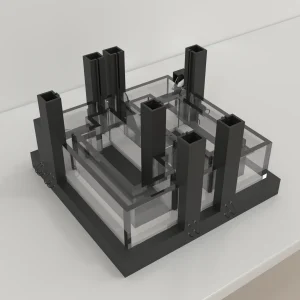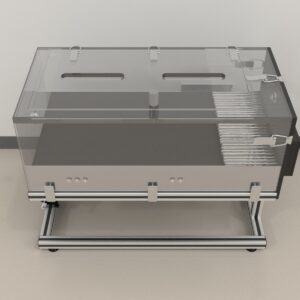$2,900.00
The Grip Strength Test, introduced in the 1970s (Meyer et al., 1979; Cabe et al., 1978), is a well-established tool for assessing motor function in rodents, including rats and mice.
This testing apparatus features both small and large grip plates to accommodate different rodent strains. It measures tensile force and conveniently provides mean values for analysis.
Equipped with an error elimination function, the instrument can efficiently filter out operational mistakes, remove inaccurate values, and enhance data reliability. It also allows for real-time data reading via a PC connection.
The apparatus can be utilized for testing either forelimb or hindlimb grip strength.
Maze Engineers provides the Grip Strength Test system.




Grip Strength Test |
Gripping plate area: mouse 20×20 cm and rat 25x25cm |
Stainless steel; detachable gripping plate |
Power supply voltage: AC 190V-230V 50HZ |
Power: 20W |
Maximum tensile force: Range: 0 – 50 N (5kgf) Reading accuracy: 0.1g steps Release time measure in 0.1s steps Error: ≤ 0.3g
Peak Force Time Resistance LED touch screen display
Two grip plates (Mice and Rats) Optional: custom grids are available

Take advantage of Neuralynx, Ethovision Integration, SMS and Email integration with the Conductor Science Software. No I/O Boxes Required

The Grip Strength Test is utilized to evaluate neuromuscular function and muscle strength (Meyer et al., 1979; Cabe et al., 1978). This assessment measures the maximum force needed to induce the subject to release its grip. It is included in the functional observational battery (FOB) for assessing neurobehavioral toxicity. Weakness in muscle strength and function can arise from neurodegenerative diseases like Parkinson’s, clinical conditions such as motor neuron disorders, nutritional deficiencies, or injuries.
In the Grip Strength task, the subject is gently lifted by the tail, allowing it to grasp the grip plate with either its forelimbs or hindlimbs. The subject is then pulled until it releases its hold. The force exerted at the moment of release serves as an indicator of grip strength.
The Grip Strength Test apparatus features a baseplate, a trapezoidal stainless-steel grip, and a force sensor. This sensor is linked to a computer for data recording. The system includes two sizes of grip plates—large and small—designed for use with various animal sizes.
Clean the apparatus before and after every trial. To measure grip strength, gently lift the subject by the tail such that its fore paws or hind paws can grasp onto the steel grip. Gently pull the subject away from the apparatus by the tail until it releases its grip. Allow at least a one-minute resting period in between trials. Perform at least 3 trials per subject.
Coradinia et al. (2015) investigated the functionality of monosodium glutamate (MSG)-induced obese Wistar rats. The subjects were divided into three groups: MSG-treated, MSG-treated with right median nerve compression, and MSG-treated with injury that received swimming overload treatment. Each MSG-treated group had a corresponding control group. The swimming treatment involved progressively increasing durations of exercise (20, 30, and 40 minutes) over three weeks. Grip strength tests were conducted on postoperative days 3, 7, 14, and 21. The results indicated that both the control and obese groups demonstrated better grip strength compared to the other groups. This finding suggests that swimming treatment did not effectively enhance muscle grip strength in the context of compression-induced injury for either the MSG-treated or control groups.
Girgis et al. (2015) examined the impact of Vitamin D deficiency and the deletion of Vitamin D receptors on the grip strength of rodents. The study involved whole-body Vitamin D receptor knockout (VDRKO) mice alongside C57BL6 mice, which were fed either a vitamin D-deplete diet or a vitamin D-control diet after three weeks on a regular chow diet. Grip strength tests indicated that VDRKO mice were considerably weaker than the wild-type controls, with grip strength decreasing from 43% at two months of age to 48% at three months. A similar trend was observed in the comparison between Vitamin D-deficient and Vitamin D-replete groups. Mice lacking adequate Vitamin D showed a grip strength reduction from 15% at two months to 25% at three months of age, relative to those receiving sufficient Vitamin D.
Xue et al. (2016) investigated the impact of Rapamycin on low-capacity runner (LCR) rats. The study included both male and female LCR rats, which were divided into two groups. The treatment group received diet pellets enriched with Rapamycin (approximately 2.24 mg/kg body weight per day), while the control group was given a placebo diet for a duration of six months. Grip strength tests revealed a significant effect of Rapamycin, with results indicating improvements of 13% in female LCR rats and 60% in male LCR rats when compared to baseline values.
The Grip Strength apparatus is used to measure the subject’s ability to hold on via its forelimbs or hindlimbs as it is pulled away from the apparatus. The following data can be recorded using the apparatus for the Grip Strength task.
The Grip Strength Test serves as a quantifiable assessment of a subject’s muscular strength. Variations in grip strength can indicate potential motor toxicity. This test is useful for evaluating the impact of various drugs on muscle function and can also be employed to assess pain levels. Additionally, the effects of dietary restrictions can be monitored through this test. Its straightforward nature makes it particularly effective for grip strength evaluation. The accompanying software minimizes operational errors, reduces false readings, and enhances the reliability of the data collected. With two sizes of grip plates, the apparatus accommodates both rats and mice, making it versatile for different species.
Proper placement of the subject is a crucial aspect of the Grip Strength Test. Inexperienced experimenters might struggle with correctly positioning the subject on the apparatus. Consistency in technique is essential for obtaining reliable data. Several factors, including how the subject is handled, dietary restrictions, body weight, and variations in sensory or non-motor functions, can significantly influence performance. Additionally, excessive testing may result in muscle fatigue. Therefore, it is important to incorporate adequate rest periods between tests to ensure accurate results.
Yes our Grip Strength apparatus is designed to be used for both fore and hind paw grip strength
Our Grip Strength includes all necessary software and data can be uploaded to PC
1x meter, 2x rectangular grids, 2x mouse forepaws grids, 2x rat forepaws grids
No data is saved on the device itself, values are taken manually.
You can use the program to run the experiment and the data is saved via our software on your computer when connected via USB (with USB driver installed).
There are no questions yet. Be the first to ask a question about this product.
Monday – Friday
9 AM – 5 PM EST
DISCLAIMER: ConductScience and affiliate products are NOT designed for human consumption, testing, or clinical utilization. They are designed for pre-clinical utilization only. Customers purchasing apparatus for the purposes of scientific research or veterinary care affirm adherence to applicable regulatory bodies for the country in which their research or care is conducted.